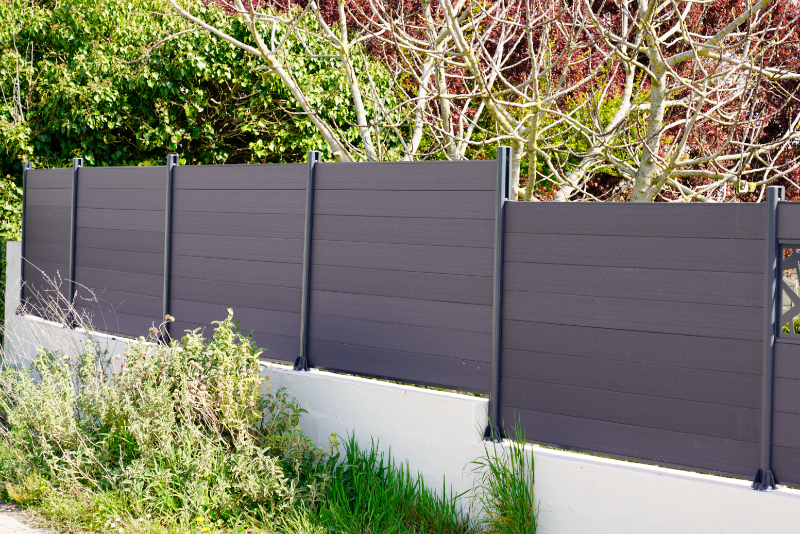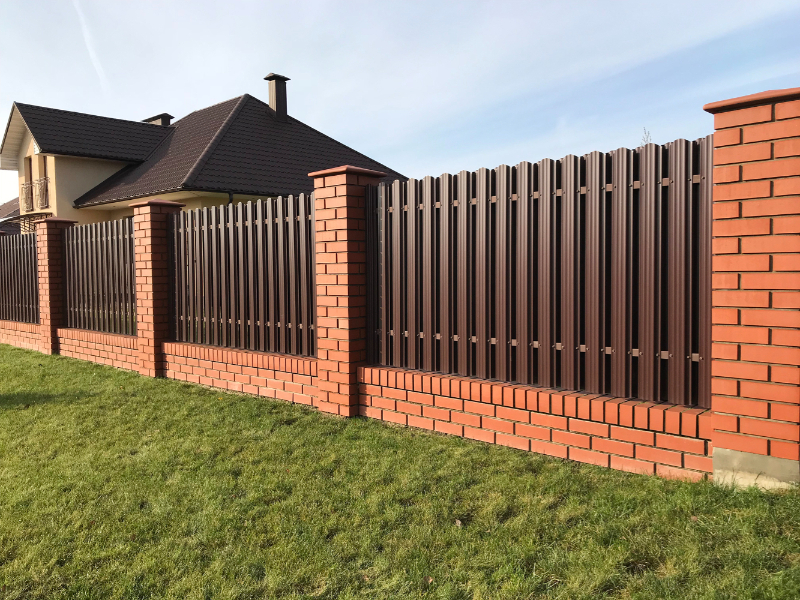This article asks: is it hard to install a fence by yourself? MD Fencing & Decking are local fencing contractors working in Milton Keynes, Buckinghamshire. We look at various types of fencing and how difficult they are to put up.
Is it hard to install a wood fence?
Installing a wooden fence can be a challenging but rewarding DIY project. The difficulty is influenced by several elements such as the height and width you choose, the soil's composition, and the necessity for planning permission if the fence borders a neighbour’s property.
To get started, mark the fence line using a string as a guide to ensure it runs straight. Dig post holes deep enough to securely hold the posts. If you encounter rocks or tough soil, the process becomes more difficult. Use a spirit level to check that the first post is vertical and fix it with setting concrete. Pressure-treated wood is recommended for durability.
Attach gravel boards at the bottom to protect the fence from wet soil. Fix horizontal rails, then attach vertical panels with a hammer and screws. It's essential to check that the top of the fence is level. Throughout the installation, follow guides or videos to learn the proper techniques. Engaging help from another person is almost essential. It usually takes a few days of hard work, especially if you have limited access to both sides of the fence.
In summary, installing a wood fence is laborious and requires attention to detail. If you're not up for the task, hiring a professional could save time and ensure a polished finish.
Is it hard to install a composite fence?
Installing a composite fence, similar to vinyl fences, involves using pre-built fence panels made of pickets. This simplifies the installation process compared to wood or chain link fences.
The composite fence panels come in pre-assembled sections, which makes achieving a consistent and uniform look easier. Instead of individually attaching pickets to rails, you can focus on accurately positioning and securing the fence panels to the posts.
To start, mark the fence line and dig post holes at the appropriate intervals. Use a spirit level to ensure the posts are vertically aligned and at the desired height. Next, attach the composite fence panels to the posts. The panels typically slide into grooves on the posts, providing a secure fit. This step-by-step process, along with the pre-built panels, simplifies the installation compared to other fencing options.
Composite fences offer the advantage of low maintenance and resistance to rot, pests, and weather elements. These qualities make them an appealing and durable option for homeowners.

Wooden Fencing

Composite Fencing
Is it hard to install a chain link fence?
Installing a chain link fence can be a challenging task for the average DIYer. The process involves handling various hardware components, such as brace bands, tension bands, rail caps, tension rods, and tension bars. Keeping track of these elements and understanding their proper placement can be daunting.
One of the key aspects of installing a chain link fence is ensuring proper tensioning. This requires the assistance of a second person to help set the chain link fabric into place and tighten it adequately. Their help is crucial for achieving a secure and stable fence.
To start the installation, the ground needs to be prepared, and post holes are dug along the fence line at regular intervals. The depth of the holes will depend on the desired height and stability of the fence. Once the holes are ready, the posts are carefully positioned and secured with setting concrete to ensure long-term durability.
Next, the chain link fabric is attached to the posts using the necessary hardware components, such as brace bands and tension bands. These components help hold the fabric securely and provide the required tension along the fence line.
Rail caps, tension rods, and tension bars further contribute to the overall stability of the fence. Installing a chain link fence demands attention to detail, as each step must be executed correctly for a secure and visually appealing result. It is a time-consuming process, especially when working with larger fence areas.
Is it hard to install a metal fence?
Installing a metal fence follows a similar process to other fence installations. While it involves digging, once the post holes are set, the process becomes more straightforward.
You set the posts in concrete, attach the fence panels, and repeat until your fence is complete. To begin, mark the fence line and dig the post holes to provide support and stability. Set the metal posts vertically in concrete, ensuring they are straight and aligned.
After the concrete sets, attach the metal fence panels to the posts using brackets or screws. Follow the manufacturer's instructions for your specific fence system. Repeat the process of setting the posts and attaching the panels until the fence is complete. Pay attention to alignment and spacing for an aesthetically pleasing result.

Chain Fencing

Metal Fencing
Before you begin installing a fence
Planning to install a fence on your property? Before you embark on this project, it's essential to consider several key factors and follow the necessary steps to ensure a successful and hassle-free installation.
From communicating with neighbours and defining boundaries to obtaining planning permission and prioritizing safety, taking these precautions will help you navigate the process smoothly.
Neighbours and Boundaries
Maintaining good communication with your neighbours is crucial when installing a fence that adjoins their property.
It's important to discuss your plans with them to ensure mutual understanding and avoid potential disputes or misunderstandings. In some cases, the exact line of the boundary may not align precisely with the property's deeds. Clarifying the boundaries will help ensure that you build the fence within your property lines.
It's also crucial to confirm the ownership of the existing fence before removing it. If the fence belongs to your neighbour and they don't want it taken down, you may need to explore alternatives.
Erecting a new fence alongside the existing one on your side of the boundary is a possible solution. While an unwritten rule suggests that the posts and rails face your own property, it's important to note that this isn't a legal obligation. The positioning of the posts can help indicate ownership if it's not clearly known.
Safety First
Prioritising safety throughout your fencing project is paramount to prevent accidents and ensure a smooth installation process. One crucial safety consideration is checking for underground service cables before digging post holes or using metal post supports.
Accidentally damaging utility lines can lead to serious consequences and disruptions. Renting a cable avoidance tool (CAT) is an effective way to locate and identify any hidden pipes or cables beneath the proposed fencing area. This step will help you avoid potential hazards and protect essential services.
If you discover service cables in the proposed fencing area, it's important to reassess your plans and ensure that your intended fence installation won't interfere with these utilities. If you plan to run a fence over a solid floor, such as a patio or driveway, using fence post supports specifically designed for such surfaces can provide a safe and secure alternative.
These supports sit on top of the concrete and are bolted to the floor, allowing the fence posts to be simply pushed into the holders.
However, if the proposed fencing area doesn't cover a solid floor and underground cables are present, it is advisable to reconsider your fencing plans or consult with professionals to find a suitable solution.
In addition to these safety considerations, there are general safety tips to keep in mind throughout the fencing installation process. It is recommended to undertake any fencing project with the assistance of a friend or family member.
Having an extra pair of hands not only makes the work easier but also enhances safety by allowing for better coordination and support. Always wear appropriate protective gear when necessary.

Depending on the specific tasks involved, this may include gloves, safety goggles, sturdy footwear, and even ear protection if using power tools. Cement-based activities, such as setting fence posts in concrete, require extra precautions. Wet cement can cause skin burns, so it's important to wash your hands thoroughly after use. Additionally, don't allow concrete to dry on your tools.
Clean off any residue with a stiff brush to maintain the tools' effectiveness and longevity. By following these safety measures and guidelines, you can proceed with your fence installation project confidently, knowing that you have taken the necessary precautions to protect yourself, your property, and the surrounding utilities.
Planning Permission
Understanding the local regulations and obtaining the necessary planning permission is important when installing a fence. In many cases, erecting a fence less than 2 meters in height doesn't require formal planning permission. However, certain circumstances may still require permission, such as if the proposed fence borders a highway or foot-path.
To ensure compliance and avoid any legal issues, we recommend contacting your Local Authority or checking their website to determine if you require planning permission for your specific fencing project. They will provide guidance on height restrictions, permitted materials, and any other specific requirements applicable to your area.
Are you looking for garden fence installation near you? If you require new wooden fencing in Milton Keynes, Buckinghamshire contact us today. Our garden design experts can supply and install beautiful fencing for you and your family to enjoy for years to come.


